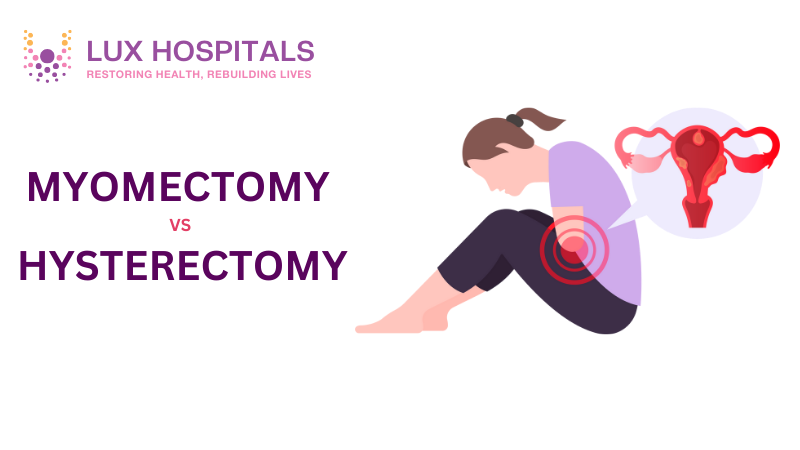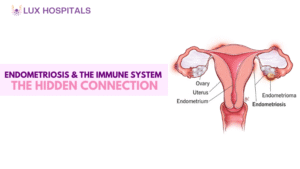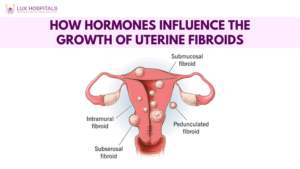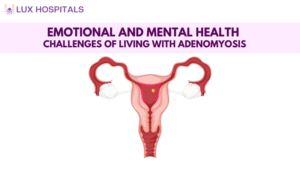Myomectomy vs Hysterectomy: Which One is Right for You?

Uterine fibroids are a common health concern among women, often leading to symptoms like heavy menstrual bleeding, pelvic pain, and discomfort. When dealing with fibroids, two surgical options are frequently considered: myomectomy vs hysterectomy.
Understanding the differences, benefits, and risks of these procedures can help you make an informed decision about the best treatment for your condition.
What is a Myomectomy?
A myomectomy is a surgical procedure designed to remove uterine fibroids while preserving the uterus. It is often recommended for women who wish to retain their fertility or keep their uterus intact for other reasons. Unlike hysterectomy surgery, which removes the entire uterus, myomectomy surgery focuses solely on fibroid removal, allowing the uterus to function normally.
Types of Myomectomy Surgery
- Abdominal Myomectomy: An open surgery where a large incision is made in the abdomen to remove fibroids.
- Laparoscopic Myomectomy: A minimally invasive procedure that uses small incisions and a camera to remove fibroids.
- Hysteroscopic Myomectomy: A procedure performed through the vagina without external incisions, typically used for smaller fibroids inside the uterus.
What is a Hysterectomy?
A hysterectomy is a surgical procedure to remove the uterus, making it a permanent solution for fibroids. This procedure is often recommended for women with large or multiple fibroids, severe symptoms, or other underlying conditions like endometriosis or uterine cancer.
Types of Hysterectomy Surgery
- Total Hysterectomy: The cervix and the entire uterus are removed.
- Subtotal (Partial) Hysterectomy: The cervix remains intact while the uterus is removed.
- Radical Hysterectomy: The uterus, cervix, and surrounding tissues are removed, usually for cancer treatment.
- Laparoscopic or Robotic Hysterectomy: A minimally invasive approach using small incisions.
Myomectomy vs Hysterectomy: Key Differences
When deciding between myomectomy vs hysterectomy, several factors come into play:
- Fertility Preservation: Myomectomy allows women to conceive in the future, whereas hysterectomy eliminates this possibility.
- Recovery Time: Myomectomy typically involves a shorter recovery period, especially with minimally invasive techniques. Hysterectomy may require a longer healing time, depending on the type of surgery performed.
- Symptom Relief: Hysterectomy provides a permanent solution for fibroids and related symptoms, while myomectomy may lead to fibroid recurrence.
- Hormonal Effects: In some cases, a hysterectomy involving ovary removal can trigger early menopause.
Who Should Consider a Myomectomy?
A myomectomy is the preferred option for women who:
- Want to retain their ability to conceive.
- Have fibroids that are causing symptoms but can be removed without a complete hysterectomy.
- Wish to avoid hormone changes that can occur after a hysterectomy.
Who Should Consider a Hysterectomy?
A hysterectomy may be the best choice for women who:
- Have severe fibroid-related symptoms that do not respond to other treatments.
- Suffer from other uterine conditions like cancer, severe endometriosis, or adenomyosis.
- They are approaching menopause and do not wish to preserve their uterus.
- Want a permanent solution without the risk of fibroid recurrence.
Pros and Cons of Myomectomy vs Hysterectomy
Myomectomy Pros:
- Preserve the uterus and fertility.
- Less invasive than a hysterectomy surgery.
- Quicker recovery time compared to open hysterectomy.
Myomectomy Cons:
- Fibroids may grow back.
- Possible scarring that may affect fertility.
- It may require a future hysterectomy if fibroids recur.
Hysterectomy Pros:
- Permanent solution with no risk of fibroid recurrence.
- Eliminates menstrual bleeding and associated symptoms.
- It can reduce the risk of uterine cancer.
Hysterectomy Cons:
- Ends fertility permanently.
- Longer recovery period compared to myomectomy surgery.
- This may lead to hormonal changes if the ovaries are removed.
Recovery Time and What to Expect
Myomectomy Recovery:
- The type of surgery varies the recovery time.
- Minimally invasive procedures take about 2-4 weeks to heal, while open myomectomy surgery may take 6 weeks.
- Patients may experience mild pain, spotting, and discomfort in the first few weeks.
Hysterectomy Recovery:
- Recovery may take 6-8 weeks for open surgery and 2-4 weeks for laparoscopic procedures.
- Patients may experience fatigue, hormonal changes, and emotional effects post-surgery.
- A long-term absence of menstrual cycles is expected.
Alternative Treatments for Fibroids
If you are uncertain about undergoing myomectomy vs hysterectomy, consider these alternative treatments:
- Hormonal Therapy: Medications like birth control pills or GnRH agonists can help shrink fibroids.
- Uterine Fibroid Embolization (UFE): An alternative to surgery that reduces fibroids by stopping their blood flow.
- MRI-Guided Focused Ultrasound: Breaks up fibroids using ultrasonic pulses
- Lifestyle Changes: Regular exercise, a balanced diet, and stress management may help control symptoms.
Choosing the Right Option for You
Several factors influence the choice between myomectomy vs hysterectomy, including:
- Desire for Future Pregnancy: If you are plan to have children, myomectomy is the better choice.
- Severity of Symptoms: If fibroids are causing extreme pain, heavy bleeding, or other complications, a hysterectomy may be necessary.
- Medical History and Overall Health: To find the best course of action for you, your doctor will review your medical history.
Conslusion
Both myomectomy vshysterectomy surgery are effective in treating uterine fibroids, but the best choice depends on your long-term goals. If you seek relief from fibroids while preserving fertility, a myomectomy may be the right choice. However, if you prefer a permanent solution, hysterectomy is the definitive option. Always discuss your options with a trusted healthcare provider to ensure the best decision for your health and well-being.




















